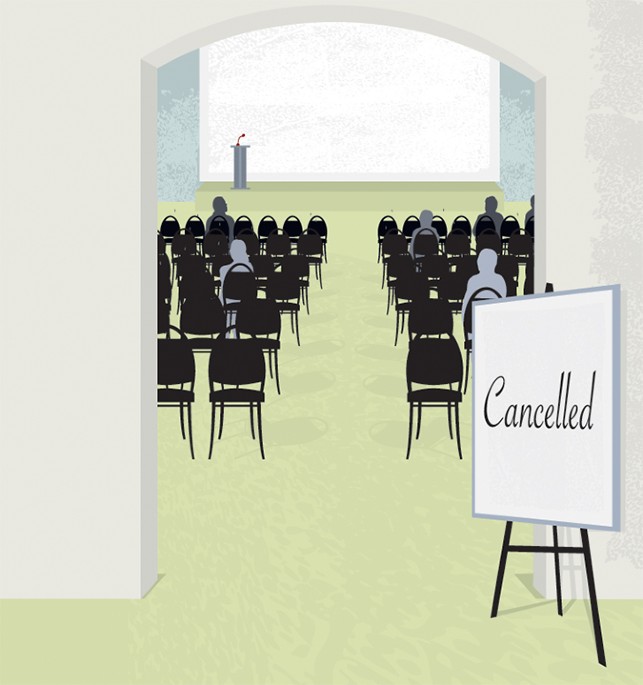
- Select a language for the TTS:
- UK English Female
- UK English Male
- US English Female
- US English Male
- Australian Female
- Australian Male
- Language selected: (auto detect) - EN
Play all audios:
Organizers are starting to drop meetings, thanks to falling attendance and budget squeezes. Citing flagging attendance and falling revenue, two scientific organizations are scaling back
their conference rosters. The American Society for Microbiology (ASM) in Washington DC has cut out most of its small specialized conferences, and the European Molecular Biology Organization
(EMBO) in Heidelberg, Germany, has dropped its large annual meeting in favour of speciality events. Every year since 2014, the ASM has sponsored seven to ten specialized conferences that
each drew several hundred attendees. But attendance has dropped by 5–10% since then, says David Hooper, head of the Infection Control Unit at Massachusetts General Hospital in Boston and
chair of the ASM's meetings board, probably because of tightened purse strings and a growing need for cross-discipline collaborations, which are more easily fostered at larger meetings.
The society will now host just one or two small conferences each year, including one on next-generation sequencing and one on cell communication in bacteria. It has also committed to
keeping a meeting on biofilms that it has scheduled for next October in Washington DC. Hooper says that the society will not trim its medium-sized or larger conferences, which continue to
draw thousands of attendees. Those include the popular Biothreats conference, slated for February in Baltimore, Maryland. ASM Microbe, the society's largest conference, which draws more
than 10,000 attendees for posters and presentations, is scheduled for next June in Atlanta, Georgia. DIFFERENT TACK Credit: Adapted from Getty EMBO, by contrast, decided to drop the annual
EMBO Meeting after a sharp decline in attendance in 2015 and 2016, says programme manager Gerlind Wallon. In 2009 and 2010, the first years of its existence, the meeting drew close to 1,500
participants. But by 2016, attendance had halved. “Scientists, particularly the younger ones, are economizing to go to more specialist conferences,” she says. Small meetings seem to be more
successful for EMBO, which has not seen a comparable decline in the number of attendees or presenters at those speciality events, including more than 60 meetings this year. Although some had
lower attendance than expected, others had higher, Wallon says. Since 2009, she adds, EMBO has seen a 50% increase in the number of scientists applying for grants to organize meetings.
Attendance at the some of the world's largest science conferences has stayed relatively steady in recent years. The Society for Neuroscience in Washington DC reported that more than
24,300 scientists attended its annual meeting last year in San Diego, California, just slightly below the average for the previous five years. And the European Society of Cardiology Congress
brought more than 32,800 delegates to Rome in 2016, matching its 10-year high. Hooper notes that the ASM may change its line-up and the content of smaller conferences according to input
from its advisory panel. He also says that it is unclear why attendance has fallen at smaller ASM conferences, but notes that researchers have had to make hard choices. “One can't go to
multiple conferences every year,” he says. Authors * Chris Woolston View author publications You can also search for this author inPubMed Google Scholar RELATED LINKS RELATED LINKS RELATED
LINKS IN NATURE RESEARCH Sustainability: A greener culture A clean, green science machine Biotech audience shrinks RELATED EXTERNAL LINKS American Society for Microbiology European Molecular
Biology Organization RIGHTS AND PERMISSIONS Reprints and permissions ABOUT THIS ARTICLE CITE THIS ARTICLE Woolston, C. Societies reconsider conference plans. _Nature_ 550, 147 (2017).
https://doi.org/10.1038/nj7674-147a Download citation * Published: 05 October 2017 * Issue Date: 05 October 2017 * DOI: https://doi.org/10.1038/nj7674-147a SHARE THIS ARTICLE Anyone you
share the following link with will be able to read this content: Get shareable link Sorry, a shareable link is not currently available for this article. Copy to clipboard Provided by the
Springer Nature SharedIt content-sharing initiative





